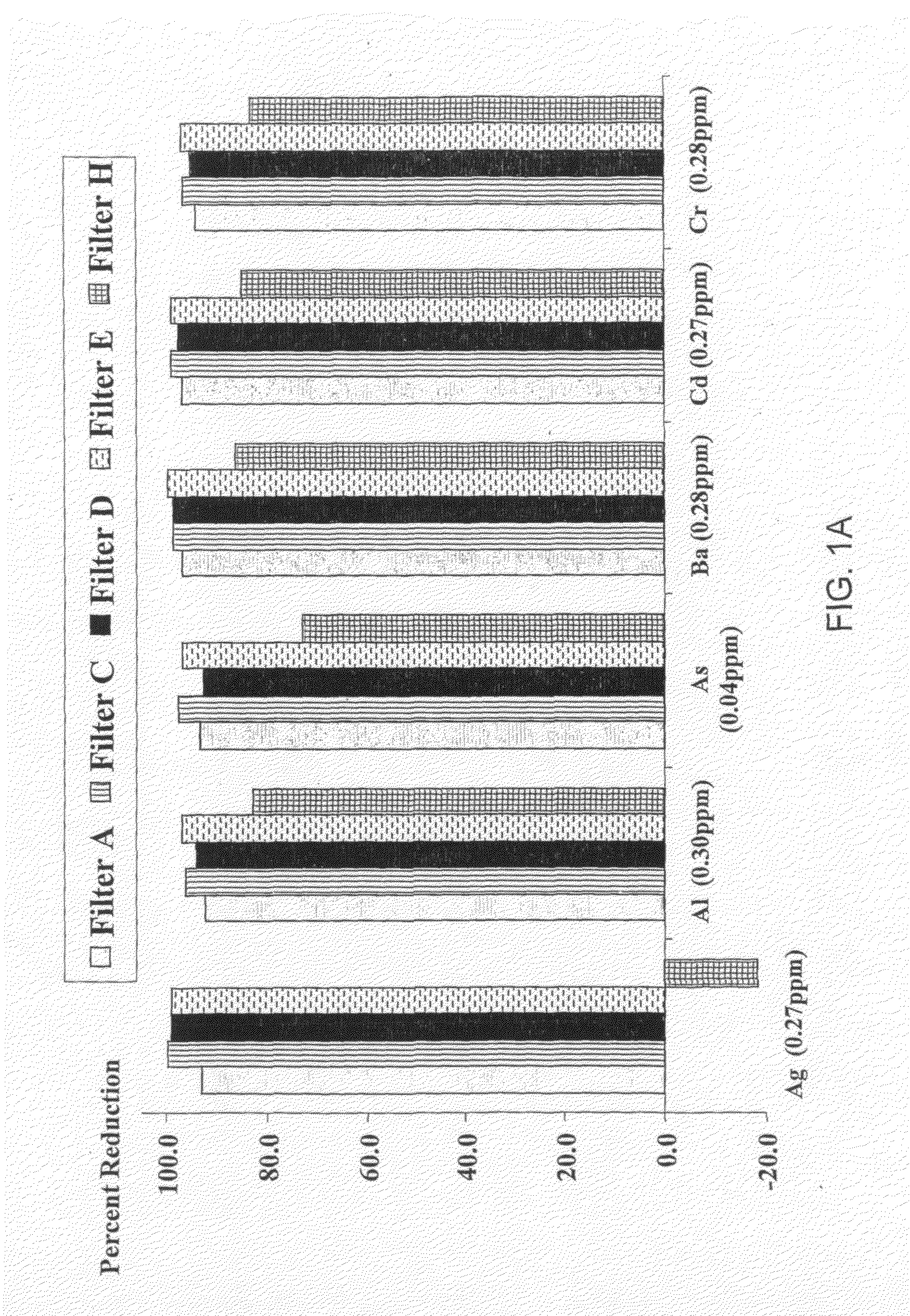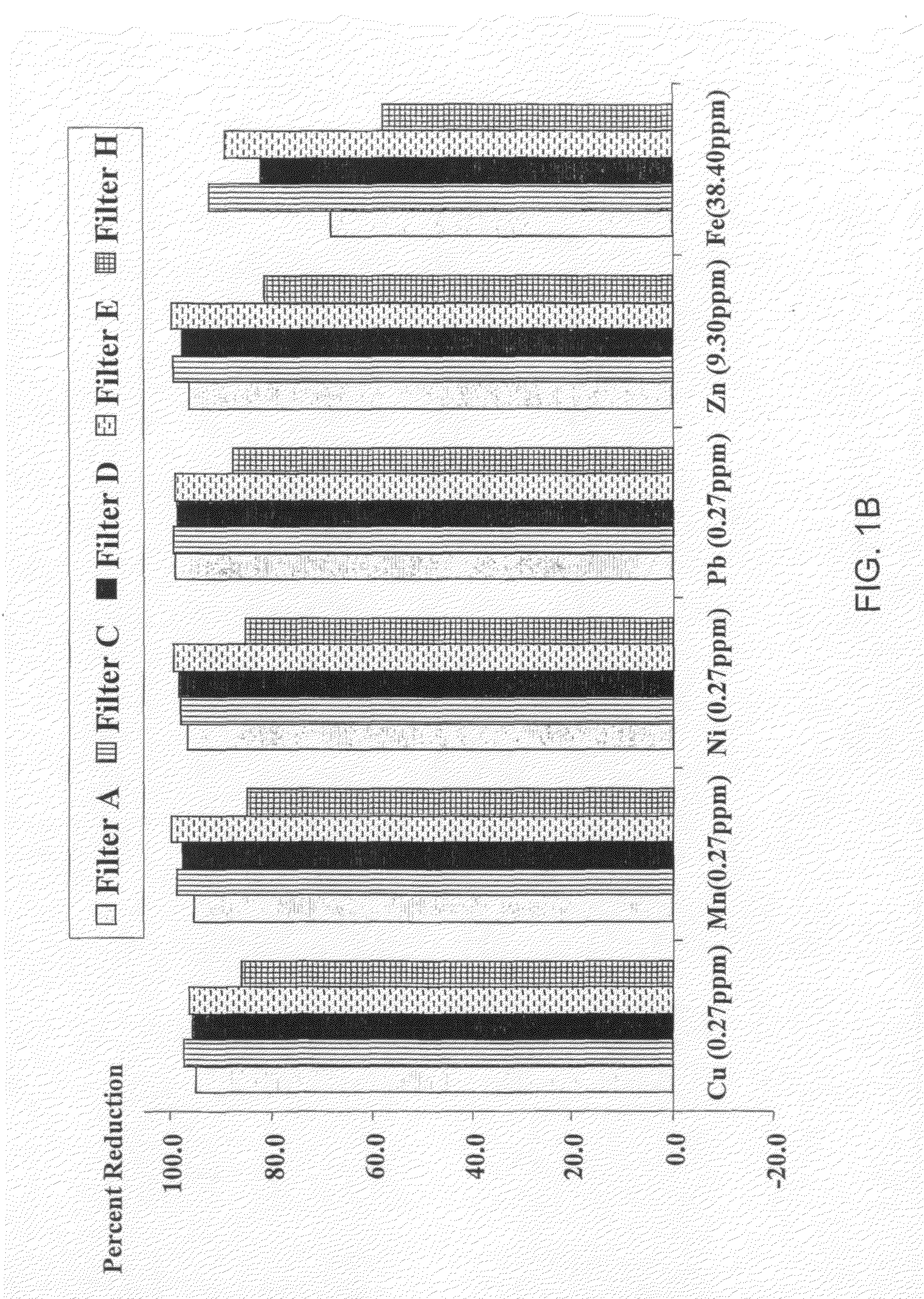Filter medium
a filter medium and filter medium technology, applied in the field of filter medium, can solve the problems of physical and chemical blockage of contaminants, and achieve the effect of preventing the blockage of contaminants
- Summary
- Abstract
- Description
- Claims
- Application Information
AI Technical Summary
Benefits of technology
Problems solved by technology
Method used
Image
Examples
example 1
Preparation of a Filter Medium
[0108]Basic integrated filter (herein referred to as filter A) contains activated carbon impregnated with 1.05% silver (35 g), cationic exchangers based on crosslinked polystyrene containing sulfonic acid groups with 40% of its acidic groups present as potassium salt (14 g) and chitosan flakes (2 g). The tested filters were prepared by mixing the components and filling the mixture in the appropriate filter holders. The filters were initially washed with 2 liters of water prior to use. The filter was tested for its effectiveness in removing inorganic and organic contaminants.
[0109]pH adjustment—One-liter samples of tap water at pH 5 and 9 (pH adjusted by using HCl and NaOH as needed) were filtered through the basic integrated filter (filter A). The pH after filtration was between 6.8 and 7.4. The pH after filtration through a commercial filter, produced by Brita and purchased in a local store (containing a mixture of carbon and sulfonated ion exchange ag...
example 2
Crosslinking of Chitosan
[0134]Nine samples of 1 g chitosan each (99% deacetylated) where left in closed glass vials at 150° C. for different periods of time, as follows:
[0135]sample no. 1 for 5 min;
[0136]sample no. 2 for 10 min;
[0137]sample no. 3 for 15 min;
[0138]sample no. 4 for 30 min;
[0139]sample no. 5 for 45 min;
[0140]sample no. 6 for 1.5 hours;
[0141]sample no. 7 for 3 hours;
[0142]sample no. 8 for 6 hours;
[0143]sample no. 9 for 24 hours.
[0144]All samples were cooled to room temperature after removal from the oven. For the evaluation of crosslinking between and within the chitosan polymer chains a solubility test was performed, as follows: 100 mg samples of the chitosan of the nine samples in 5 ml 5% acetic acid aqueous solution were mixed at room temperature for 10 min and 60 minutes. As control, 100 mg of the untreated chitosan was dissolved under the same conditions.
[0145]Untreated chitosan completely dissolved and gave a homogeneous yellowish solution. Sample nos. 1-2 formed ...
example 3
[0149]3 g of chitosan (18.75 mmol, DA=8.2%) dissolved in 150 ml of 1% acetic acid was reacted with 0.75 mmol of glutaraldehyde (0.04 equimolar, 0.3 ml of 25% w / w aqueous solution) which was added dropwise. The mixture was stirred at room temperature for 1 hour. Ethanol (210 ml) and octanal (18.75 mmol, 1 equimolar) were added to the flask. The solution was stirred for 2 hours at room temperature before NaCNBH3 (2.49 g; 2 equimolar) was added to reduce the imine bonds to amines and the stirring was continued for additional 1.5 hours under the same conditions. White precipitate was obtained during this reduction step. The pH was adjusted to 10 and the product was isolated by filtration. The white powder was washed with several portions of ethanol and water and vacuum-dried over P2O5 pellets over night. Average yield: 73% (w / w).
[0150]FT-IR (KBr): 1149 cm−1 (C—O), 1460 cm−1 (C—H, aliphatic), 2926 cm−1 and 2854 cm−1 (C—C, aliphatic) and 3420 cm−1 (—NH, —OH groups). ...
PUM
| Property | Measurement | Unit |
|---|---|---|
| pore size | aaaaa | aaaaa |
| temperatures | aaaaa | aaaaa |
| buffering capacity | aaaaa | aaaaa |
Abstract
Description
Claims
Application Information
 Login to View More
Login to View More - R&D
- Intellectual Property
- Life Sciences
- Materials
- Tech Scout
- Unparalleled Data Quality
- Higher Quality Content
- 60% Fewer Hallucinations
Browse by: Latest US Patents, China's latest patents, Technical Efficacy Thesaurus, Application Domain, Technology Topic, Popular Technical Reports.
© 2025 PatSnap. All rights reserved.Legal|Privacy policy|Modern Slavery Act Transparency Statement|Sitemap|About US| Contact US: help@patsnap.com



